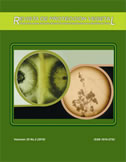Amblyseius largoensis (MUMA), THE ONLY SPECIES COLLECTED TOGETHER WITH THE RED PALM MITE
Contenido principal del artículo
Resumen
Dear Editor:
In October19, 2008, in “La Marina”, Santiago de Cuba, and in March 3, 2009, in “El Salvador”, in Guantánamo, both in Cuba, we observed an abundant population of the red palm mite (Raoiella indica Hirst) (Acari:Tenuipalpidae) together a relative profuse population of a predator mite of the Phytoseiidae family on the underside of coconut leaves. Different species of phytoseids were expected to be found, as it was common in other agroecosystems researched by us, but all the taxonomic characters (dorsal shield chetotaxy, ventral setae and shields, legs, chelicerae, spermatheca and spermatodacty shape) had a total coincidence with only one species: Amblyseius largoensis (Muma) (Acari: Phytoseiidae). Hence, we decided to initiate further studies on this species using the red palm mite as food to find out its real role over this invasive alien species.
In October19, 2008, in “La Marina”, Santiago de Cuba, and in March 3, 2009, in “El Salvador”, in Guantánamo, both in Cuba, we observed an abundant population of the red palm mite (Raoiella indica Hirst) (Acari:Tenuipalpidae) together a relative profuse population of a predator mite of the Phytoseiidae family on the underside of coconut leaves. Different species of phytoseids were expected to be found, as it was common in other agroecosystems researched by us, but all the taxonomic characters (dorsal shield chetotaxy, ventral setae and shields, legs, chelicerae, spermatheca and spermatodacty shape) had a total coincidence with only one species: Amblyseius largoensis (Muma) (Acari: Phytoseiidae). Hence, we decided to initiate further studies on this species using the red palm mite as food to find out its real role over this invasive alien species.
Detalles del artículo
Cómo citar
1.
Ramos M, Flores-Galano G, Rodríguez H. Amblyseius largoensis (MUMA), THE ONLY SPECIES COLLECTED TOGETHER WITH THE RED PALM MITE. Rev. Protección Veg. [Internet]. 13 de junio de 2010 [citado 15 de diciembre de 2025];25(2):134. Disponible en: https://revistas.censa.edu.cu/index.php/RPV/article/view/297
Número
Sección
CARTA AL EDITOR
Aquellos autores/as que tengan publicaciones con esta revista, aceptan los términos siguientes:
- Los autores/as conservarán sus derechos de autor y garantizarán a la revista el derecho de primera publicación de su obra, el cual estará simultáneamente sujeto a la Licencia Creative Commons Attribution-NonCommercial 4.0 International (CC BY-NC 4.0) que permite a terceros compartir la obra, siempre que se indique su autor y la primera publicación en esta revista. Bajo esta licencia el autor será libre de:
- Compartir — copiar y redistribuir el material en cualquier medio o formato
- Adaptar — remezclar, transformar y crear a partir del material
- El licenciador no puede revocar estas libertades mientras cumpla con los términos de la licencia
Bajo las siguientes condiciones:
- Reconocimiento — Debe reconocer adecuadamente la autoría, proporcionar un enlace a la licencia e indicar si se han realizado cambios. Puede hacerlo de cualquier manera razonable, pero no de una manera que sugiera que tiene el apoyo del licenciador o lo recibe por el uso que hace.
- NoComercial — No puede utilizar el material para una finalidad comercial.
- No hay restricciones adicionales — No puede aplicar términos legales o medidas tecnológicas que legalmente restrinjan realizar aquello que la licencia permite.
- Los autores/as podrán adoptar otros acuerdos de licencia no exclusiva de distribución de la versión de la obra publicada (p. ej.: depositarla en un archivo telemático institucional o publicarla en un volumen monográfico) siempre que se indique la publicación inicial en esta revista.
- Se permite y recomienda a los autores/as difundir su obra a través de Internet (p. ej.: en archivos telemáticos institucionales o en su página web) antes y durante el proceso de envío, lo cual puede producir intercambios interesantes y aumentar las citas de la obra publicada. (Véase El efecto del acceso abierto).
